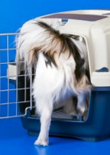
 Have you ever wondered how professional trainers are able to crate train a puppy and get him or her to be quiet while inside?
Have you ever wondered how professional trainers are able to crate train a puppy and get him or her to be quiet while inside?
In this article, not only will you learn exactly how to crate train a puppy, but you will also learn a very effective way of conditioning your puppy to absolutely love his crate. This type of training is used throughout the world by professional dog trainers as a way of building a positive association to things, dogs, situations or in this case: to his crate.
The very first thing that you must do is find out what your puppy finds highly valuable. Let your puppy tell you what he or she finds valuable. If your puppy loves treats, experiment and try to find the one special type of treat that your puppy goes crazy for. Is it chicken, pork, sausage or cheese? Observe your puppy’s behavior and see which one your puppy is most enthusiastic about.
If your puppy is not food motivated, no worries! You can use his favorite toy instead. And of course, there is always your voice and physical touch which you can use to praise and reward your puppy. By knowing what your dog values the most, it will allow you to transfer that value into something else.
Are you ready to start conditioning your puppy? Don’t worry, this part is easy! Place your crate in the middle of a room with the door open, and let your puppy wander about. Don’t say anything; just wait quietly for your puppy to enter the crate on his own. As soon as your puppy enters the crate, immediately throw your reinforcement inside the crate, whether it is a treat, a toy or by verbally praising and cheering him or her for entering the crate.
By doing this, your puppy will learn that good things happen when he goes inside the crate. After just a few repetitions, your puppy will want to go inside the crate on his own because it is a source of goodies.
Note: In the beginning, it is important not to close the door behind him while he is in the crate. Many dog owners make the mistake of putting their puppy inside the crate, closing the door and leaving. Doing this creates a negative association to the crate, because the puppy loses his freedom and is not in any way reinforced for going inside the crate.
To summarize, learning how to crate train a puppy isn’t complicated, you simply have to make the crate a fun thing to be around. In the first few weeks that you bring your puppy home, I highly recommend that you play this game with your puppy and continue to build a positive association. Eventually, you can wait a second or two before giving your reinforcement. This will build duration to the behavior of being inside the crate.
To learn more about effective and positive ways of training your puppy, register to our dog forum and talk to hundreds of other dog owners who have dealt with the very same struggles you are facing today.
Session expired
Please log in again. The login page will open in a new tab. After logging in you can close it and return to this page.
Hi Jean, I have a suggestion for a new blog post 🙂 “How To Stop Your Dog From Jumping Up On People.” I know my dog does this and I hate it! There are a lot of great posts here, going to take me a while to read!